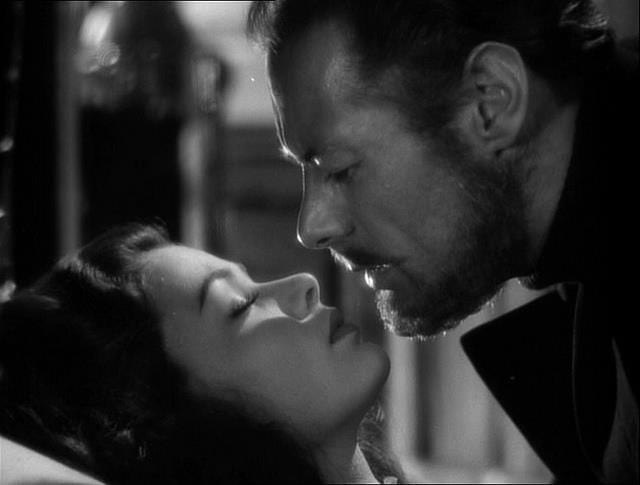
There’s always been something about cinephilia, particularly that classic form of cinephilia (well known to many us) which fetishizes old Hollywood films, that strikes me as a little bit morbid. Films capture a series of moves and gestures that remain permanent — the movies always stay the same, though our reactions change almost invariably with each viewing. Etched in light and embalmed on celluloid, the faces and spaces of the screen become essences which occupy psychic space within us. We often watch films from the ‘30s and ‘40s in which most or all of the actors up on the screen are by now long dead. The ritualistic act of reviving older films, of watching them together in dark, silent rooms, and on occasion watching them on crackling, slowly decaying archival prints, ultimately amounts to a beautiful séance of sorts. Because cinema is full of ghosts, film culture is necessarily steeped in death.
Perhaps for this very reason, cinema seems an especially suitable medium for stories in which a character from the earthly realm (i.e., a spectator) communes with a phantom. One of my favorite subgenres in film history is the ghost romance, a form which combines the movies’ natural inclination toward the uncanny, the supernatural, and the dreamlike, with its equally strong penchant for eroticism and the matters of romantic love. The idea of a living person falling in love with a ghost has been the throughline which links a very special group of films, from Ugetsu (Kenji Mizoguchi, 1953) to Brigadoon (Vincente Minnelli, 1954) to Legend of the Mountain (King Hu, 1979). This notion also permeates other major films in less literal, more metonymic forms, as in the cases of Laura (Otto Preminger, 1944) and Vertigo (Alfred Hitchcock, 1958). All of these films possess a very mysterious quality that somehow seems to evoke the myth of cinephilia itself: every film buff has, while watching the films that they hold most dear, fallen in love with ghosts, too.

All of this brings us to Joseph L. Mankiewicz’s sublime masterpiece of 1947, The Ghost and Mrs. Muir, perhaps the apotheosis of the ghost romance in cinema. Set in the early 1900s, the film tells the story of Lucy Muir, a recently widowed young woman who moves into the haunted Gull Cottage with her young daughter and her maid. (Muir is, of course, played by the luminous Gene Tierney, the subject of a retrospective this semester at IU Cinema.) Soon after moving in, Muir encounters the ghost of the home’s previous owner, Captain Daniel Gregg, hilariously played by the underrated Rex Harrison.
Though the final moments of the film represent a crescendo of profound waves of emotion, many of the film’s early passages are played as light comedy; we watch with delight as the two characters’ initial resistance toward one another relaxes into an ethereal companionship. While Muir decides to ease her financial struggles by “ghostwriting” a book recounting the Captain’s naval adventures, the budding romance between them is very natural, based as it is in mutual friendship. There’s something about the film, even in these more lighthearted moments, that completely overwhelms me on an emotional level: the actors so fully inhabit their characters that they seem to take on an almost literary richness and depth.

The Ghost and Mrs. Muir can also be discussed in terms of its two primary environments, the cottage and the sea. The domestic space of the home may be traditionally seen as a conservative domain of established and safe social relationships, but here Gull Cottage becomes a fascinating and enchanted space, the site where all the romancing happens. It’s the place where Captain Gregg comes to call upon Lucy, where he occasionally even eavesdrops on her conversations with others. In this sense, the rooms of the cottage become completely alive at all moments, haunted by a phantom but also brimming with the adventurous possibilities of romance and excitement.
Mankiewicz seems to conceive of the sea as an image of eternity: only Captain Gregg, in his current, ghostly form, seems permitted to inhabit its watery depths. The final image of the film depicts two people moving out toward the sea — an image which evokes the act of going beyond our world and into another, more expansive one. For me, this expressive use of environments and its relationship to the film’s fictional elements becomes a key to understanding Mankiewicz’s directorial style. Fred Camper writes persuasively that, “The details of [Mankiewicz’s] frames, not just a character but a background object or a doorway, the overall architecture of the spaces, all become invested with the suggestiveness of words.”

What we’re left with at the film’s conclusion is an image of the beloved as intangible, which might be read as a metaphor for our own cinephilia. The tension in the film between images of permanence and images of the fleeting or the transitory becomes centrally linked to its cinematic allure. Mankiewicz seems to suggest that, in our earthly lives, perhaps we can never truly grasp the essence of the things we love — as in a movie, we can only replay certain images or moments in an endless haunting.
The Ghost and Mrs. Muir plays at IU Cinema on September 26 at 1 pm as part of the series Sunday Matinee Classics: A Century of Tierney.
Mankiewicz’s classic All About Eve (1950) was also screened there in December of 2018.

Jack Miller enjoys the films of Howard Hawks, Jacques Tourneur and John Ford. He graduated from Indiana University with a BA in English, and currently resides in Chicago. He also enjoys listening to country and disco music.